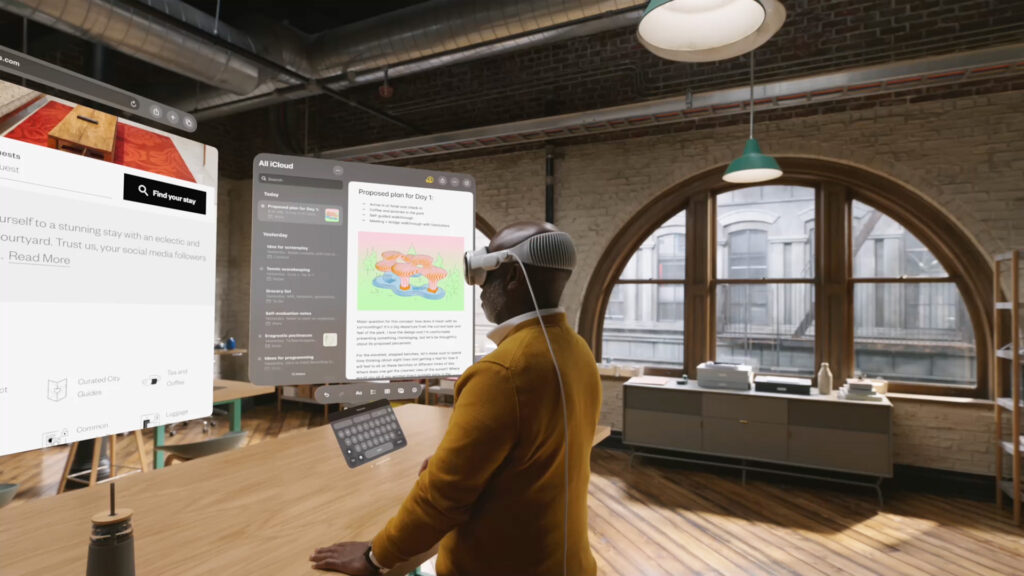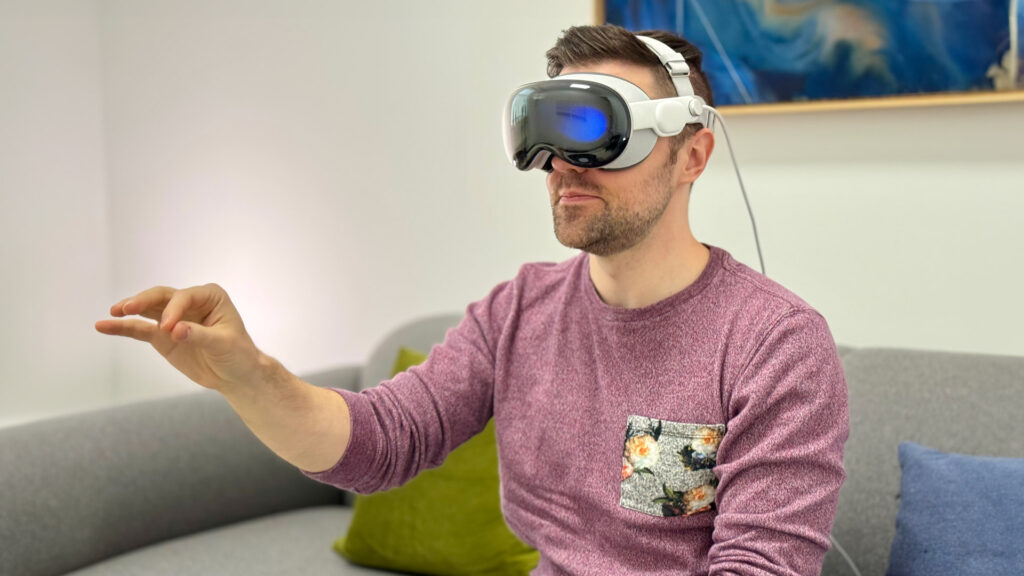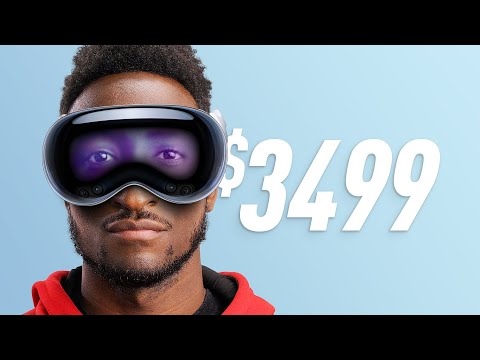The new Apple Vision Pro carries substantial expectations as Apple’s much-anticipated foray into wearable computing.
Priced at $3,499, Apple introduces the Vision Pro as the dawn of “spatial computing,” a concept that involves interacting with applications in the space surrounding you.
The company’s marketing doesn’t shy away from these high expectations, depicting users engaged with the Vision Pro in a variety of everyday scenarios—whether at work, managing household chores, or spending time with family.
The goal is ambitious: to seamlessly integrate applications and information with the physical world, enhancing our interaction with augmented reality.
But the million dollar question is – WHY SHOULD YOU CARE? WHAT DOES IT MEAN FOR YOUR BUSINESS?
In this blog, we attempt to answer this very question.

The Vision Pro Ecosystem
Apple’s decision to release the Vision Pro at WWDC 23, despite it not being available for purchase until early 2024 and initially only in the United States, was a strategic choice.
WWDC serves as Apple’s platform for engaging with developers, encouraging them to create applications for its new software ecosystems.
VisionOS, the latest addition, is designed to work in harmony with iOS and iPadOS, introducing new spatial dynamics that developers need to account for in their new and upcoming applications.
Apple aims to avoid the limitations it faced with the iPhone’s first generation, which restricted app development to a select group of developers.
The goal is to foster a broad application ecosystem, ensuring that users find their preferred apps on this new platform. Apple plans to streamline the process for developers to adapt their existing iOS/iPadOS apps for VisionOS, reminiscent of the transition strategy used during the iPad’s introduction.

Marketing Use Cases of Apple Vision Pro for Your Business
Below are fifteen potential use cases that illustrate the potential of Vision Pro in marketing for your business:
Immersive Product Demonstrations: Vision Pro enables a new way to showcase products by offering 3D, lifelike demonstrations. Customers can explore every detail, interact with products in a virtual space, and experience them in a way photos and videos can’t match. This immersive approach helps bridge the gap between digital browsing and physical shopping, potentially increasing conversion rates by providing a more informed purchasing decision.
Remote Collaboration: Vision Pro’s video calling and shared virtual spaces offer a unique solution for remote teams. This technology facilitates a collaborative environment where ideas can be brainstormed and visualized in real-time, irrespective of the physical location of team members. It enhances creativity, speeds up the decision-making process, and allows for the instant sharing of concepts and designs, making remote work more efficient and connected.
Virtual Reality Advertising: Leveraging Vision Pro’s capabilities for VR advertising transforms how brands engage with their audience. By immersing customers in interactive, virtual environments, advertisers can create memorable experiences that captivate users’ attention far more effectively than traditional ads. This method allows for storytelling and product interaction in a dynamic space, opening up new creative avenues for marketing campaigns.
Virtual Event Marketing: Vision Pro can change virtual events by offering attendees an immersive experience that closely mirrors physical attendance. From virtual trade shows to product launches, attendees can navigate through 3D spaces, interact with exhibitors or products, and even network with others, making virtual events more interactive and engaging than ever before.
Consumer Research: Conducting consumer research through Vision Pro provides an engaging and immersive way to gather insights. By placing participants in virtual scenarios or environments, companies can observe behaviors and reactions to stimuli more naturally than through traditional surveys. This method offers deeper insights into consumer preferences and decision-making processes, enabling more targeted marketing strategies.
Personalized Customer Journeys: Vision Pro offers the tools to create personalized shopping experiences, guiding customers through a virtual store tailored to their preferences. By analyzing past behaviors and preferences, brands can present a curated selection of products, recommend new discoveries, and even simulate how products would look in real-life settings, offering a deeply personalized and engaging shopping journey.
Content Creation: With Vision Pro, content creation takes on a new dimension. Marketers can utilize AI-powered tools within a VR environment to craft engaging, professional-quality content. This could include virtual tours, interactive product showcases, or even narrative-driven brand stories, providing audiences with experiences that are not just seen but felt.
Training and Education: Vision Pro can be a powerful tool for creating immersive training and educational content, especially useful for complex product demonstrations or explaining services in detail. Through realistic simulations, employees and customers can gain a better understanding of products, leading to improved customer service and more knowledgeable staff.
Influencer Marketing: Influencers using Vision Pro can create content that’s more engaging and immersive than traditional video or images. By offering followers the chance to step into their world, experience products, or explore places in 3D, influencers can forge stronger connections with their audience, making influencer marketing campaigns more effective and memorable.
Data Visualization: With Vision Pro, marketing teams can visualize complex data in a 3D, immersive environment. This makes understanding intricate patterns, customer behaviors, and market trends easier and more intuitive. Presenting data in this engaging format can facilitate more informed decision-making and bring to life statistics and analytics that would be flat and less impactful in a traditional presentation.
Virtual Showrooms: Retailers can use Vision Pro to create virtual showrooms, allowing customers to explore products in a detailed, simulated environment. This not only enhances the shopping experience but also reduces the limitations of physical space and inventory, enabling customers to browse an extensive collection without leaving their homes, potentially increasing sales and customer satisfaction.
Interactive Storytelling: Vision Pro enables marketers to tell their brand’s story in an interactive, engaging manner. Customers can become part of the story, exploring environments, making choices, and experiencing the brand narrative firsthand. This level of engagement can lead to a deeper emotional connection with the brand, enhancing loyalty and brand recall.
Customer Support: Enhancing customer support with Vision Pro means offering real-time, interactive assistance. Support agents can visually guide customers through solutions, demonstrate how to resolve issues, or showcase product features in a virtual environment. This can significantly improve customer satisfaction by making support more comprehensive, personalized, and engaging.
Augmented Reality Marketing: Vision Pro’s AR capabilities allow marketers to overlay digital information onto the real world, creating innovative campaigns. For example, customers can see how furniture would look in their homes or how clothes would fit without physically trying them on. This perfect blend of virtual and real elements can make marketing campaigns more alluring to the customer base.

Final Verdict
So to say the least, the device is pretty cool.
Vision Pro is setting a new standard for how businesses operate and connect with consumers.
For designers and creative professionals, the tool offers a new medium for innovation, allowing for the creation and manipulation of 3D models in a virtual space.
For small and medium businesses, though, it’s a little early to invest in the current bulky model that costs quite a bit. But we’re sure the subsequent models would become more accessible, affordable and easy to wear in the time to come.
What are your thoughts on Apple’s latest innovation? Do you think it’ll change the world as much as the iPhone did? Can you think of any other use cases, tell us in the comments.





 Booking System
Booking System eCommerce
eCommerce On-Demand Services
On-Demand Services Community App
Community App Ordering App
Ordering App Loyalty App
Loyalty App Online Learning
Online Learning Directory
Directory Marketplace
Marketplace SaaS
SaaS P2P Platform
P2P Platform eHailing
eHailing Healthcare
Healthcare Finance
Finance Logistics
Logistics Education
Education Food & Beverage
Food & Beverage Retail
Retail FMCG
FMCG Sports
Sports Travelling
Travelling Manufacturing
Manufacturing Renewable Energy
Renewable Energy Mobile Application Development
Mobile Application Development Web Application Development
Web Application Development Source Code Review
Source Code Review Internet of Things (IoT)
Internet of Things (IoT) Cyber Security
Cyber Security